The global crisis and the "yellow threat" led to the arms race in the Asia-Pacific countries
The situation is spurred by the United States, which regroup forces and assets, making the Asia-Pacific region the main object of their attention. Washington strengthens its position in Japan, South Korea, the Philippines and Australia. The US strategy is as old as the world - divide and conquer. Washington is not going to be in the forefront of the fight against Beijing. However, Americans are pushing competitors and potential opponents of the Middle Kingdom. Washington’s strategy is to preserve American dominance in the region by maintaining a balance of power that is advantageous for the United States and preventing the emergence of a state or coalition of equal power.
According to experts of the analytical corporation RAND and the Lexington Institute, the development of the military programs of India, Indonesia, Taiwan, Japan, the DPRK and South Korea is of the greatest interest following the 2013 results.
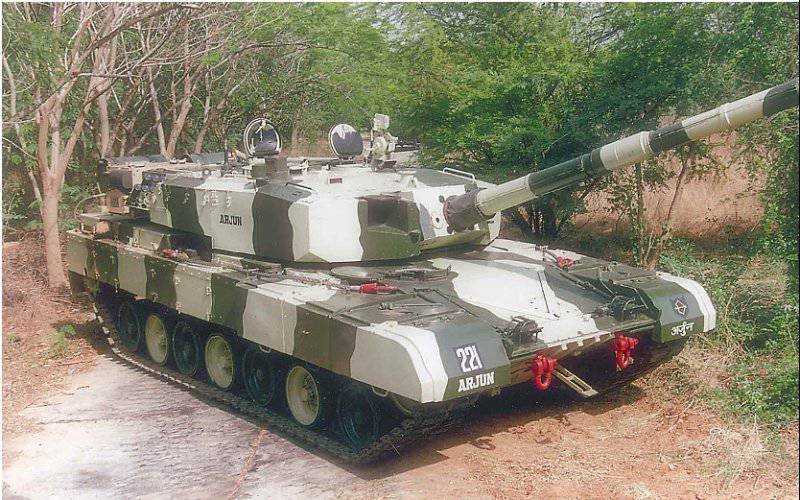
Arjun Mk.II.
India
In New Delhi practically straight talkthat the main potential opponents of the country are Pakistan and China. Therefore, India must be ready for a war on two fronts. China’s desire to gain a foothold in the countries surrounding India, creating a “ring of suffocation”, causes great concern. Chinese armed forces are trying to establish themselves in the Indian Ocean, which was considered the traditional sphere of influence of Delhi.
The "Mina" in the relations of India and China was laid by the British. British India - it included the territories of modern India, Pakistan and Bangladesh, was the most important British colony. In 1914, the British colonial authorities and representatives of the Tibetan government conducted the so-called the line of McMahon, the border between India and Tibet. After the inclusion of Tibet in China, the line of McMahon became the border between China and India. The name of the border was named after the Secretary of Foreign Affairs of British India and one of the main participants in the negotiations, Henry McMahon. The length of this line is about 890 km, it goes mainly along the Himalayas. This line as a state border is recognized by India, the government of the Dalai Lama in exile. China does not recognize this border, believing that Tibet did not have sovereignty, being part of the Chinese Empire, therefore, had no right to conclude this agreement. On Chinese maps, the area of 150 thousand square meters. km south of the McMahon Line is marked as belonging to the Tibet Autonomous Region (South Tibet).
In the fall of 1962, it came to an armed conflict. The Chinese inflicted a humiliating and crushing defeat on the Indians, and occupied South Tibet for a while. However, the USSR, the United States and Great Britain acted on the same front, declared China an aggressor and promised military aid to India. China was forced to withdraw troops. From that moment on, China became the enemy of India No. 1.
At the end of the 1980s, the tendency to restore good neighborly relations between the two Asian powers prevailed. China became the first trading partner of India. In 2011, bilateral trade reached 74 billion dollars, and by 2015, it is planned to bring it to 100 billion dollars. Significantly increased Chinese investment in the economy of India. China and India bring together a significant number of common interests in the international arena. Thus, two Asian giants are cooperating in the framework of the BRICS, the SCO, the Russia-India-China triangle. Both powers are interested in the stability of Afghanistan. Delhi and Beijing interact with each other in such matters as overcoming the international financial crisis, combating international terrorism, the problem of climate change and environmental security, energy and food security.
However, this could not erase the problem of "Southern Tibet" from the memory of the Indians and the Chinese. Indian experts and the public are still closely following China’s policies in the APR and South Asia. Indian politicians and military analysts look with fear at how the PRC is modernizing the army and expanding its military advantage over India. For some in India, the “yellow threat” has already become more of a threat than Muslim Pakistan. In addition, Pakistan is now more aligned with China than the United States, which heightens the threat. The Chinese success in the development of the economy, in the field of education, science and technology allowed for a comprehensive transformation of the Armed Forces. The growth of international authority and military power allows Beijing to put pressure on its neighbors to resolve controversial issues in its favor.
New Delhi is worried about the Chinese embedding a system of unions and strong points that ensure its communication and neutralization of India. Beijing already has a network of strongpoints in Myanmar (Burma), where the Chinese have a deep-water port and are laying oil and gas pipelines to Yunnan Province. The Chinese have a good position in Bangladesh, which is traditionally hostile to India. China’s ally is Pakistan. The Chinese have established themselves on the territory of Sri Lanka (the port of Hambantota) and have plans to establish a base in the Maldives (Marao). Even Nepal, which had previously focused on India, is now looking more toward China. China establishes tight economic and military-technical ties with these states.
Given the threats posed by China and Pakistan, the Indian leadership continues to increase the military budget, purchasing military equipment and weapon in the USA, Israel, Russia and the EU countries (trying not to get into technological dependence on one country). At the same time, Delhi pays great attention to the development of the national defense industry. The Indians are rapidly modernizing almost all types and types of troops. Particular attention is paid to the development of armored vehicles (the army of Pakistan and China of an industrial type, with a large number of armored vehicles), artillery and air defense systems. The army gets Russian Tanks T-90S, they will soon be supplemented with the supply of national main battle tanks "Arjun Mk-2". As part of a joint project with Israel to create the “Future Soldier of the Future” F-INSAS (Futuristic Infantry Soldier As a System), Indian infantry is gradually being equipped with new electronics, communications and weapons. Air defense and air force reinforced by a new medium-range air defense system "Akash". In particular, in 2010, the Indian Air Force adopted the Akash air defense system, which became part of the program to strengthen the country's north-eastern borders. An anti-aircraft missile system protects strategic areas, including airfields, bridges in the Brahmaputra region, power plants and railway junctions.
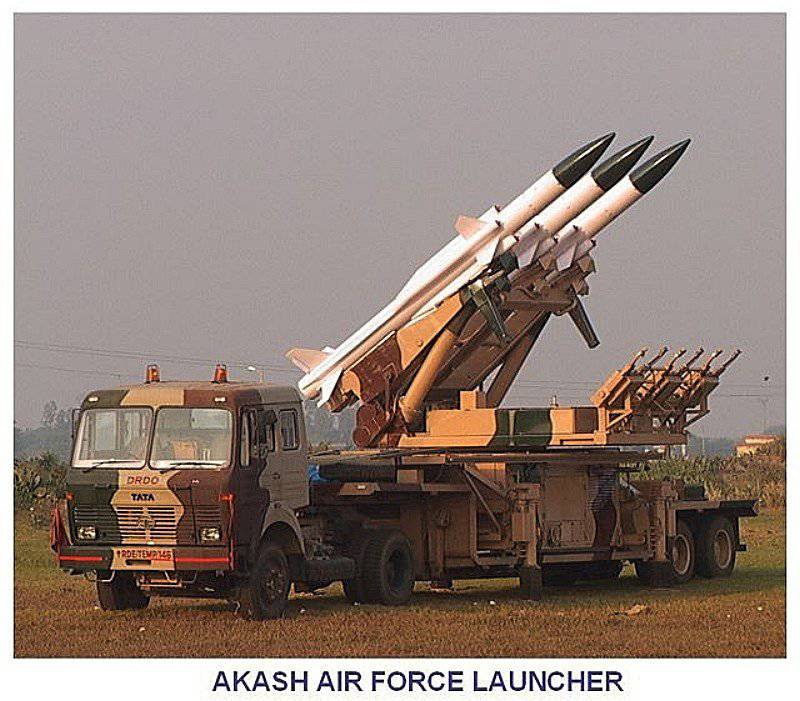
India continues large-scale rearmament of its navy. In November, 2013, Russia handed over to India the aircraft carrier Vikramaditya (former heavy aircraft carrier cruiser Admiral Gorshkov). January 8 2014 appeared news on the arrival of the aircraft carrier at the naval base Karwar on the coast of the southern Indian state of Karnataka. Now, along with the old Viraat (former British Hermes), India has two aircraft carriers. In addition, the 12 of August 2013, the first national 40000-ton aircraft carrier "Vikrant" was launched. It is planned to pass the Navy in 2018 year. In total, India plans to build an 3 ship of this type.
INS aircraft carrier Vikramaitya (R-33) accompanied by the aircraft carrier INS Viraat (R-22) in the Indian Ocean. In the background - the frigate INS Teg and the destroyer INS Mumbai
In the near future, the Indian Navy will receive 3 destroyers of Project 15A Calcutta. The destroyers will be armed with 16 anti-ship missiles BrahMos and SAM Barak. In 2011, the Indian Ministry of National Defense signed a contract for the construction of the 3rd series of new project 15B destroyers. Ships will be handed over the fleet in 2018-2024 These ships will receive cruise missiles with a nuclear warhead and extended-range air defense systems of a joint Indian-Israeli development. Between 1999 and 2013, the Indian Navy received a series of six Talwar frigates built in Russia. It is possible to purchase another series of frigates in Russia.
Surface fleet will strengthen the purchase of a batch of 8 anti-mine defense ships. The contract with the South Korean company Kangnam is estimated at 1,2 billion dollars. The Indian Navy will receive ships in 2016-2018. The first two ships will be built in Busan (South Korea), the other six - in India. The Indian Navy also announced a tender for the construction of 4 amphibious assault ships. The contract amount is estimated at 2,6 billion. Two ships will be built by the winning company, another two by the Indian company Hindustan Shipyard Limited (HSL). Thus, India plans to seriously strengthen the amphibious capabilities of the armed forces.
Opportunities for maritime patrolling will be strengthened by the supply of American P-8I Poseidon aircraft (8 aircraft ordered, 3 received). Adapted to the requirements of the Indian Navy patrol anti-submarine aircraft received the name P-8I "Neptune". They are armed with Harpoon anti-ship missiles, Mk.54 anti-submarine torpedoes and Mk.82 bombs. In total, India wants to have at least 24 long-range anti-submarine aircraft. Marine features aviation will also strengthen the purchase of Japanese ShinMaywa US-2 seaplanes. A preliminary agreement on their purchase was reached in December 2013. The Indian Ministry of Defense announced a tender for the supply of nine amphibious aircraft at the end of 2010.
The submarine fleet was strengthened with the purchase of 6 submarines of the Scorpen type from France. Their delivery is expected in 2015-2018. The Indian Navy gradually acquire and nuclear submarines. In January, 2012, Russia leased India to the 10 years of the NPS submarine of the 971U Shchuka-B K-152 Nerpa for India. In the Indian Navy, it was called "Chakra." The Russian boat is needed by India to train crews of five Arihant-class submarines. The lead ship was launched in the 2012 year. Submarines will be armed with X-NUMX K-12 Sagarika ballistic missiles with a range from 15 to 750 kilometers. At the beginning of 1500, the BR tests were successfully completed. The missile is capable of carrying a conventional or nuclear warhead weighing up to a ton. In the future, submarines can arm Agni-2013 ballistic missiles, with a range of thousands of kilometers from 3.
Very impressive and successes in the field of air weapons. The Indian Defense Ministry chose the French Rafale as the medium multipurpose fighter. By latest informationIn the near future, a contract will be signed for the purchase of 18 fighters, which will be completely manufactured by Dassault Aviation. The contract for the remaining 108 aircraft will be concluded after the national elections, they are scheduled for the end of March. Negotiations are also under way to purchase A330MRTT airbus tankers from Airbus (6 machines).
At the same time, the Indian military plans to increase the Su-30MKI park to 272 machines. Delhi is also involved in the project to create the 5 generation of the FGFA generation (based on the Russian T-50). Total plan to put into service more than 200 aircraft. At the beginning of 2014, the company announced the resumption of the design program for the advanced 5 generation fighter AMCA (Advanced Medium Combat Aircraft). The development of AMCA was suspended due to the need to concentrate on refining Tejas fighter jets. New combat aircraft promise to put on the wing in 2018 year. The fighter must fill the gap between the light Tejas fighters and the heavy FGFAs.
At the end of 2013, the Tejas lightweight fighter received initial operational approval. Now it can be delivered to the troops. The Indian Air Force ordered 40 new Tejas light fighters. Their delivery is due to begin in the summer of 2014, and end in 2016-2017. Later, the Indian Air Force plans to get a second batch of Tejas fighters in the Mk.II version with more powerful engines and increased armaments nomenclature and combat load (up to 100 machines).
In addition, by the end of 2014, the Indian Air Force should receive all Boeing C-17 Globemaster III strategic military transport planes (10 machines). At the end of 2013 of the year, there was news of India’s readiness to buy an additional batch of Lockheed Martin C-6J Hercules transport planes from 130 (the Air Force already has 6 machines). The Brazilian company Embraer has acquired the 3 of the EMB-145 long-range radar detection and control aircraft. In 2012, the Ministry of Defense of India purchased an AH-22E Apache attack helicopter for the Air Force. There is information about the purchase of an additional batch of American attack helicopters for ground forces, including for air support of mountain formations.
India’s nuclear program is also developing successfully. They are armed with short-range missiles (PRM) “Prithvi”, medium-range ballistic missiles “Agni-I” (700 — 900 km) and “Agni-II” (2-3 thousand km). India adopted the Agni III ballistic missiles (3,5-5 thousand km). In December, 2013 passed the next successful tests of Angi-3. She will also have a naval version for Arihant type submarines. Agni-5 ICBMs are under development (more than 5 thousand km.).
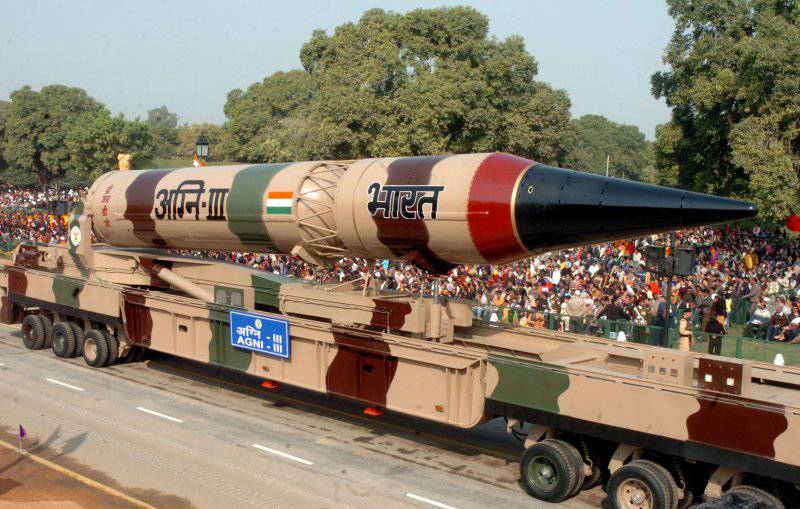
It should be noted that, despite the global crisis and some decline in the Indian economy, the large-scale rearmament of the Indian Armed Forces continues. GDP growth in 2010 was 10,1%, in 2011 - 6,8%, in 2012 - 4,7%. Negative trends were noted in the 2013 year. The past few years, the growth of inflation. However, the military budget is constantly increasing. According to the British Institute for Strategic Studies, defense spending accounts for about 2% of India's GDP. In 2011, they were 25 billion US dollars, in 2012 year - 27,6 billion dollars, in 2013 year - 31,2 billion dollars (according to other data, 36 billion dollars). It is expected that by 2015, defense spending will increase to 42-45 billion dollars. And this is despite the planned reduction in government spending. The latter will not affect the defense sphere.
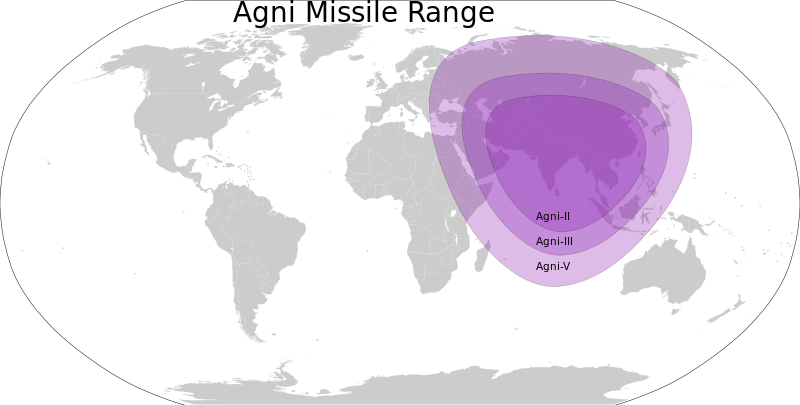
Agni missile strike radius
To be continued ...
- Alexander Samsonov
- The global crisis and the "yellow threat" led to the arms race in the Asia-Pacific countries
The global crisis and the “yellow threat” led to the arms race of the countries of the Asia-Pacific Region. Part of 2
The global crisis and the “yellow threat” led to the arms race of the countries of the Asia-Pacific Region. Part of 3
The global crisis and the “yellow threat” led to the arms race of the countries of the Asia-Pacific Region. Part of 4. The threat of the emergence of "Asian NATO"
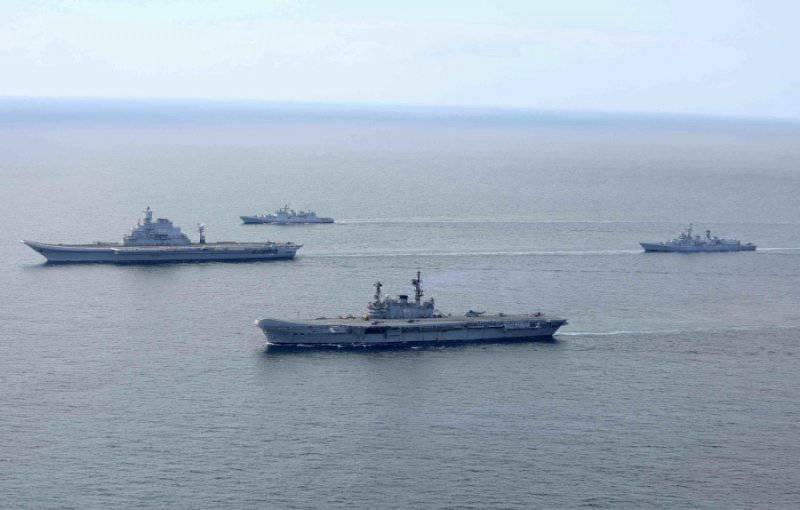
Information